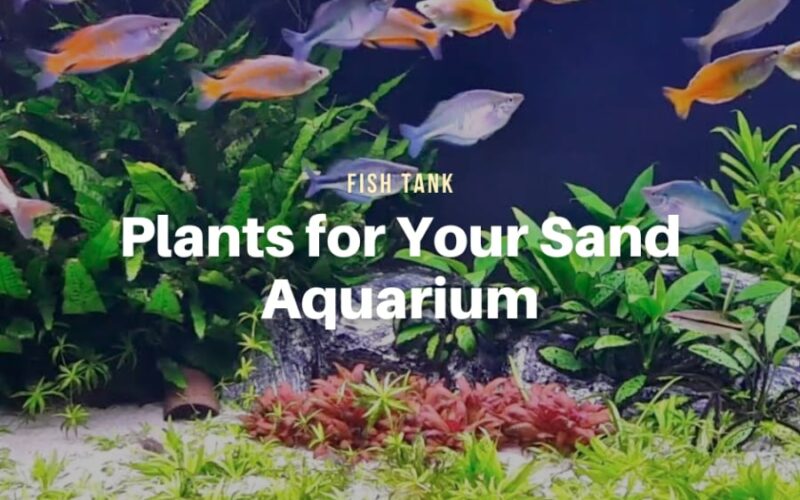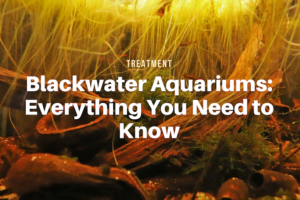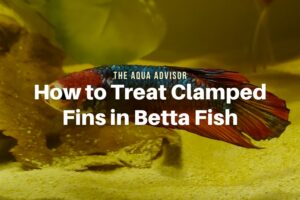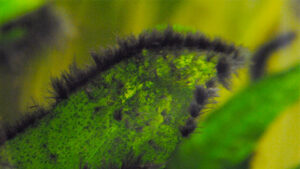Looking for recommended plants for your sand aquarium? When it comes to aquarium substrate, sand is definitely a solid option. How could it not? Sand is more natural than gravel, easier to clean, and, well, it just looks beautiful. Not to mention some fish benefit from sand, too.
As good as it is as an aquarium substrate, not all plants can grow in sand. It doesn’t provide plants with much-needed nutrients. Due to its small pore and gritty texture, the substrate might suffocate the roots of certain plants, too.
So, the question is, what are the best plants for a sand aquarium?
Is Sand Safe for Aquariums?
Before we get to our list of recommended plants for your sand aquarium, let’s talk about the safety of sand as a substrate. Sand is safe for aquariums.
But, like any other substrate, sand has its advantages and disadvantages. Depending on your aquarium situation, it might suit or might not suit your aquarium.
Advantages
Some advantages using sand in your aquarium:
It is more natural than gravel
Sand may not be as popular as gravel, but it has a much more natural appeal. Compared to an aquarium with gravel, a sand aquarium looks more natural. The latter looks more like a micro-ecosystem than an ordinary fish tank.
It is easy to clean and maintain
Contrary to popular belief, sand is easy to clean and maintain. Cleaning a sand aquarium is a bit different from cleaning an aquarium with a different substrate, yes. But the overall cleaning process is no more difficult or time-consuming.
Due to its very fine texture, dirt particles will not seep through it. Rather, they will stay on top, which makes cleaning a lot easier and less time-consuming.
It looks beautiful
Beauty is in the eye of the beholder but we can all agree on how good a well-maintained sand aquarium looks. Not to mention sand substrate mimics the natural habitats of fish, be it a river bed or ocean floor, which makes it even better.
It benefits many species of fish
Did you know that many species of fish consume sand to help out with digestion? In addition, for bottom-feeding, burrowing and soft-bellied species, sand is the best substrate option. Due to the very fine and soft texture, sand will not hurt those fish.
Disadvantages
Using sand in your aquarium also comes with some disadvantages:
It doesn’t provide plants with much-needed nutrients
One of the downsides of sand as a substrate is that it doesn’t provide plants with much-needed nutrients. Thus, it is not ideal for certain aquatic plants. That said, some plants can grow on sand. You will find out soon about them from our list of recommended plants for your sand aquarium.
It can damage water filters and pumps
Due to its texture, sand can get kicked up into the water and might get sucked into filters and pumps. This can cause damage to the equipment. Thus, sand needs to be handled carefully, especially during water changes
Possibility of developing anaerobic zones
Anaerobic zones might develop in a sand aquarium. But this can be prevented by regularly stirring up the substrate and keeping fish that burrow into the substrate.
Aquarium Plants That Can Grow in Sand
So, what kind of plants that can grow in your sand fish tank?
Amazon Swords
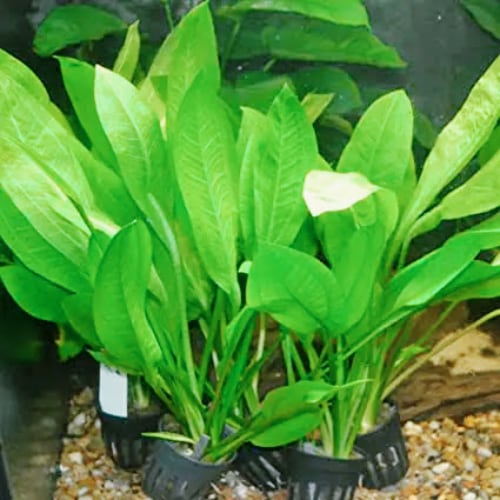
- Maintenance: Medium
- Temperature: 72 to 82 Fahrenheit
- pH: 6.5 to 7.5
- Size: 20 inches
- Fertilizer: Root tabs and iron-rich
- Lighting: Moderate
One of the plants for your sand aquarium is the Amazon Sword and for good reason. For starters, Amazon Sword is a beautiful plant. If you want to make your sand aquarium more beautiful, then look no further than the Amazon Sword.
Amazon Swords have long leaves, which grow and become increasingly attractive under the right circumstances. The beautiful plant is also beginner-friendly. If this is your first time planting aquatic plants in your aquarium, the Amazon Sword makes a great start.
Amazon Swords can adapt to various living conditions as well. This is why they are quite popular among fish keepers. Keep in mind that Amazon Swords are a heavy root feeder. That means the plants need root tabs. If you don’t add root tabs in your aquarium, the plants might look dull and unhealthy.
Java Moss
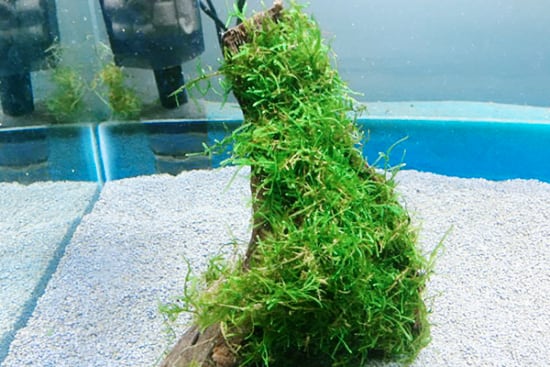
- Maintenance: Low
- Temperature: 68 to 82 Fahrenheit
- pH: 6 to 7.5
- Size: 8 inches
- Fertilizer: Not required
- Lighting: Low to moderate
Perhaps you are looking for sand aquarium plants that require little maintenance. In that case, check out Java Moss. Compared to other plants that we listed, Java Moss is the toughest one. It is no wonder that Java Moss is one of beginners’ first choices.
Java Moss grows lush green leaves, which look good on a sand aquarium. Similar to Amazon Sword, Java Moss can grow in various living conditions. This is made possible thanks to Java Moss’ rhizoids, which enable it to absorb nutrients from any surface it is kept on.
What’s more, the plant grows perfectly fine even without any CO2 or fertilizer. While Java Moss is a tough plant that requires little maintenance, it does like living in an excellent current zone. So if you want your Java Moss to thrive, put it in an aquarium with good water movement.
Anacharis
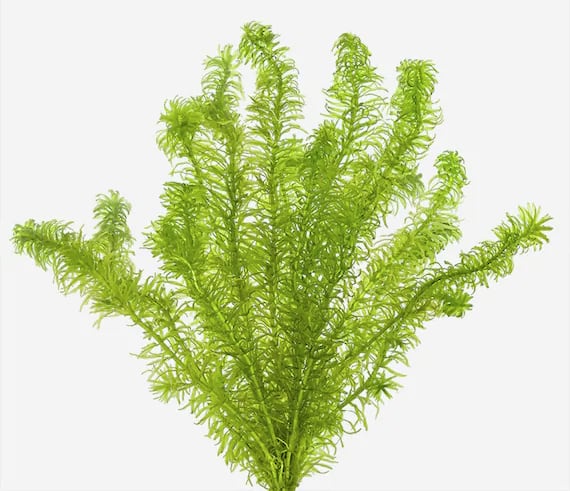
- Maintenance: Medium
- Temperature: 59 to 82 Fahrenheit
- pH: 6.5 to 7.5
- Size: 24 inches
- Fertilizer: Not required
- Lighting: Moderate
Anacharis is the next recommended plant for sand aquarium. The plant is also known as waterweed, which is hardly surprising considering how fast it grows. If you like to see the progress of your aquatic plant quickly, you will love Anacharis.
What’s more, Anacharis is not just an attractive aquatic plant, but also a tough one. The plant just doesn’t care whether it grows in soil or sand. It thrives as its roots can absorb nutrients from even the harshest living conditions.
The fast growth of Anacharis means you will need to trim it now and then. If you don’t trim it, it will take over your aquarium very quickly.
Also, while Anacharis doesn’t demand much, it does require proper lighting to survive. Without proper lighting, the plant will die. So, be sure that your aquarium has proper lighting.
Madagascar Lace
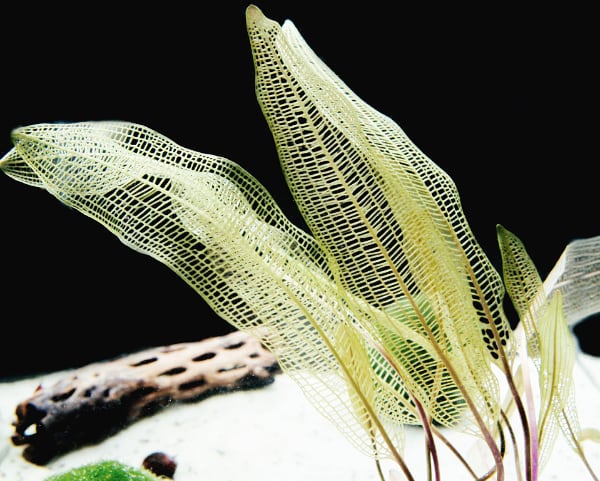
- Maintenance: High
- Temperature: 62 to 72 Fahrenheit
- pH: 6 to 7
- Size: 25 inches
- Fertilizer: Water column fertilizer that includes iron and trace elements
- Lighting: High
Among recommended plants for sand fish tank that grow lush green leaves is Madagascar Lace. Growing a Madagascar Lace in your sand aquarium will make it more appealing. Plus, the plant offers plenty of space for your fish to relax and hide.
Sounds amazing, isn’t it? The bad news is that Madagascar Lace is difficult to grow. Yes, it can grow on a sand substrate, but it doesn’t thrive on just about any type of sand. Madagascar Lace grows best on coarse sand. Moreover, it requires fertilizers.
If you want to keep your Madagascar Lace happy, consider using a good-quality water column fertilizer in your aquarium. If you offer the plant everything it needs to thrive, you will be rewarded with a stunning plant. The plant is demanding. If you think you can’t maintain it, you might want to skip it.
Anubias Barteri
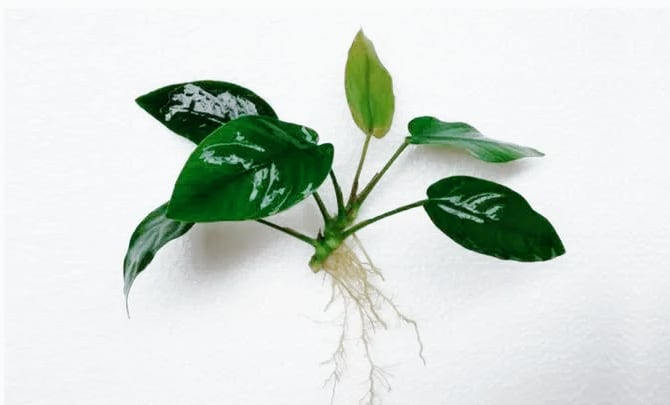
- Maintenance: Low
- Temperature: 72 to 82 Fahrenheit
- pH: 6.5 to 7.5
- Size: 12 inches
- Fertilizer: Not required
- Lighting: Low to moderate
The next aquatic plant on our list is Anubias Barteri. Like Java Moss, it is a tough plant that can thrive with little maintenance.
For ideal growth, attach the plant to rocks then anchor it in the substrate. When you bury the plant in the sand, make sure to leave the rhizomes uncovered.
Its toughness and low maintenance is not the only reason why we include it as one of the recommended for your sand aquarium, however. The plant adds a beautiful visual point to a sand aquarium. Yes, it is that stunning.
Keep in mind that Anubias Barteri is a slow-growing plant, so a bit of patience is required. The plant does not need CO2 or fertilization. It can survive without them. That said, adding them doesn’t hurt, either.
Java Fern
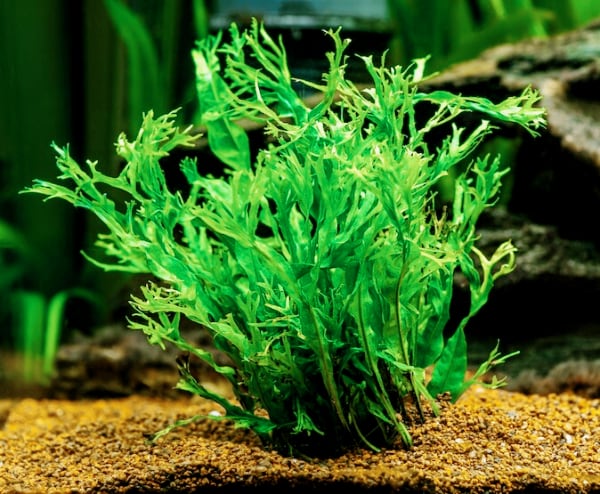
- Maintenance: Low
- Temperature: 68 to 82 Fahrenheit
- pH: 6 to 7.5
- Size: 13 inches
- Fertilizer: Not required, but CO2 can help the plant grows faster
- Lighting: Low to moderate
Firstly, the plant is suitable for both beginners and experts alike. So whether this is your first time planting a plant on a sand aquarium or you already have years of experience in it, Java Fern is a solid option.
Secondly, Java Fern propagates itself and requires low-level maintenance. All you need to do is to bury its roots deep into the substrate and ensure that its rhizome is not covered in sand. There is no need to add CO2 or fertilizer. They do help Java Fern to grow faster, but not a requirement.
Thirdly, you can combine the plant with some decorations like a rock or piece of wood by attaching the roots to them. These are why Java Fern is among our recommended plants.
Cabomba
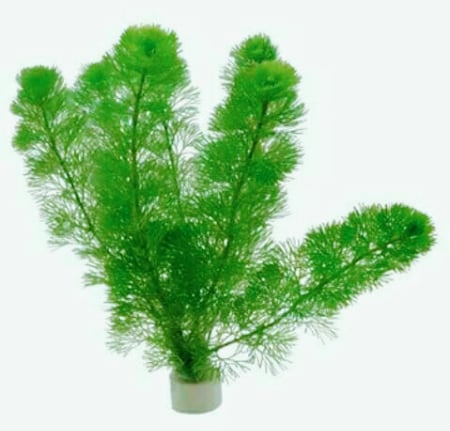
- Maintenance: Low
- Temperature: 72 to 82 Fahrenheit
- pH: 6.5 to 7.5
- Size: 20 inches
- Fertilizer: Not required
- Lighting: Moderate
Most of the recommended plants for sand aquarium are lush green. But what if you want to make your sand aquarium more colorful? Can you do it with plants? The answer is yes, you can. Take a look at Cabomba.
Cabomba is a unique aquatic plant. It comes in green and red, both of which looks quite stunning in a sand aquarium. In addition, Cabomba is well-known for its adaptability. It is also a flowering plant, which makes it even more beautiful.
Like some of the recommended plants on the list, Cabomba requires a bit of maintenance. Especially so if you don’t want the flower to die. To prevent the flower from dying, you will need to increase CO2 and add fertilizer. If you like Cabomba without flowers, you can skip it.
Dwarf Hairgrass
- Maintenance: Medium
- Temperature: 70 to 83 Fahrenheit
- pH: 6.5 to 7.5
- Size: 4 inches
- Fertilizer: Not required
- Lighting: Moderate
If you want green lush-like grass in your sand aquarium and are fine with some level of maintenance, Dwarf Hairgrass can be a good choice. The plant looks gorgeous and makes it look more natural. It is a stunning carpet plant, which is why we chose it as one of the recommended plants.
In general, Dwarf Hairgrass doesn’t require any fertilizer. The plant can grow without any fertilizer just fine. It needs CO2 and moderate lighting to grow like full carpet grass, though. What makes the plant unique is that it tends to grow in the aquarium even if it isn’t planted in the sand.
If you want Dwarf Hairgrass to spread in the entire tank, spread it out into small clumps. When the carpet look is complete, it will look absolutely stunning.
Lemon Bacopa
- Maintenance: Low
- Temperature: 68 to 82 Fahrenheit
- pH: 6 to 7.5
- Size: 2 inches
- Fertilizer: No, but the plant benefits from root tabs and water column fertilizer
- Lighting: Moderate
Lemon Bacopa is certainly a beauty. but beauty is not the only thing it offers. It is a tough plant with minimal demand and little maintenance. Indeed, it doesn’t take much for Lemon Bacopa to thrive in a sand aquarium.
Of course, that’s not to say you can’t give the plant any fertilizer. You can, but fertilizer is not a requirement. Adding fertilizer will make its leaves grow greener and bigger, which makes them even more beautiful. Not to mention the presence of Lemon Bacopa gives a natural vibe to the tank, too.
Lemon Bacopa is among the less demanding plants for your sand aquarium. That said, the plant requires moderate lighting to thrive.
Rotala Indica
- Maintenance: Medium
- Temperature: 72 to 82 Fahrenheit
- pH: 6.5 to 7.5
- Size: 14 inches
- Fertilizer: Not required, but CO2 and fertilizer help the plant to grow better and quicker
- Lighting: Moderate to high
The last on our recommended list is Rotala Indica. Compared to the others, Rotala Indicia looks a bit different. But that’s what makes the plant unique and beautiful. It is attractive on its own. When combined with others, it stands out, making the aquarium more diverse and lively.
When it comes to special requirements, Rotala Indica doesn’t demand much. It grows just fine without CO2 or fertilizer, although adding them will help the plant to grow better and quicker. It also requires moderate to high lighting.
As for maintenance, Rotala Indica’s leaves can grow big. Meaning, you will have to trim them once in a while so they don’t overwhelm the tank.
These are our recommended plants for your sand aquarium. A sand aquarium looks even better with plants growing on it. Which should you grow in your aquarium? As our list above has shown you, you have plenty of options to choose from.
Each plant requires specific conditions to thrive. Some plants require caring and maintenance. The others are tough and can thrive with just a tiny bit of care and attention. Each plant adds something to the aquarium. Putting these into consideration should make it easier for you to decide.
